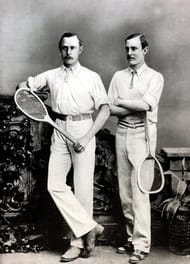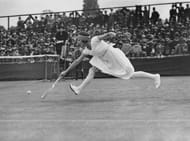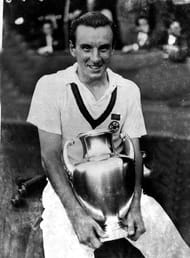The Wimbledon Championships are done for the year and all the brouhaha around Andy Murray’s achievements have been brought down to a simmer. So it would be fair for one to start thinking of what lies ahead.
But wait. It’s not so easy to let go of Wimbledon.
19th July marked the 136th anniversary of the final match of the very first Wimbledon Championship, which was held in 1877. And so, in memory of that occasion, here is a look at some of the key milestones in the history of the tournament, the All England Club and the great players who have made Wimbledon the pre-eminent event that it is.
The first Championships – 1877, and the first Ladies’ singles event – 1884
The All England Lawn Tennis and Croquet Club, which had only recently renamed itself to include this latest pastime, put out an advertisement in a magazine in the summer of 1877, which went as such –
“The All England Croquet and Lawn Tennis Club, Wimbledon, propose to hold a lawn tennis meeting, open to all amateurs, on Monday July 9th and following days”
The response for this advert was a staggering 22 men, who, after paying an entry fee of £1 and 1 shilling, went on to contest the very first Championships. The Club informed the contestants that they would have to bring their own racquets and shoes, but would be provided the balls.
Spencer Gore, who was also a cricketer, became the first champion at Wimbledon. After his victory, he remarked, “Lawn Tennis will never rank among our great games, and anybody who has played cricket or racquets will soon be choked off by the monotony.”
He was said to have a fine forehand but his skills as a seer don’t seem to be worth much.
The demand for a ladies’ event at Wimbledon was always there, given that the sport could be enjoyed by both the sexes. So in 1884, the ladies’ singles event was added to the Championships. And the prize for the ladies champion was a silver basket, worth 20 guineas. But the Club, which has always had some notoriety for being a snob, only permitted the event to be held after the men’s tournament.
The Renshaw Brothers
The all-time record for most successive Wimbledon titles won, which stands at 6, is held by William ‘Willie’ Renshaw. Between 1881 and 1889, he won 7 titles. Of course, those were the days where the champion earned an automatic qualification into the next year’s final.
William, and his younger twin (by 15 minutes), Earnest, contested three back-to-back finals. But importantly, with their style of powerful serves, volleys and smashes, they gave tennis a popularity that would last forever.
The first ‘Super Star’
That is what one might call Suzanne Lenglen. She was not just an athlete, but a performer, who danced her way through the Championships around the 1920s, winning all but 3 of her 94 matches. She won 15 titles and never lost a singles match. And it wasn’t just that.
With her half-sleeves and ankle cut dresses, brandy-sipping and make-up sessions during the sit-downs, Lenglen forever linked the sport to glamour. She is one of the reasons the event moved to larger grounds in 1922.
A New Home
With the event becoming increasingly popular and attracting far more crowds than the 200 people who had witnessed the first final, the Club decided to move to a new home. A new Centre Court was commissioned and Wimbledon could now host 13,500 enthusiastic spectators.
But even that didn’t prove to be enough and another show court was required. Court No. 1, which opened in 1924, could originally accommodate 3,250 people.
Centre Court, which today is an iconic sporting venue, has witnessed some of the greatest tennis matches of all time. Keeping pace with the times, press boxes, large screens, scoreboards and hawk-eye cameras have found a home in the venue as well. Between 2007 and 2009, Centre Court received one of its most major operations. With a retractable roof added over the court along with artificial lighting, rain delays and fading light have ceased to plague the event with stoppages.
Today, the court has a capacity to hold 15,000 spectators.
The Last Briton No More
Wimbledon history is incomplete without Fred Perry. Already a table tennis champion when he switched to tennis, Perry, with his impressive fitness and training regime (he trained with Arsenal FC), delighted the British as he won a hat-trick of Wimbledon titles culminating in 1936.
He was the first male Briton to win the tournament in over two decades then. And till two weeks ago, he was the last Briton to win for nearly eight!
The first televised Championships
Wimbledon has the unique honour of being the first sport to be televised live. In 1937, for 30 minutes each day, those within a 40 mile radius of the event could watch live tennis from the comfort of their home. The telegraph reported that, “You could observe every movement of the players and even the passage of the marks of the lawnmower over the grass were distinctly visible.”
Today, the Championships have an estimated global audience of around 378 million in 198 countries with combined footage of over 15,388 hours.
The Wars
The Championships were not held between 1915 and 1918 and again between 1940 and 1945 due to the wars. During the Second World War, the Club remained only minimally functional and was used to station several troops. Its proximity to London and its fame meant that it would be under constant threat from aerial bombers. This threat became a reality when the court was attacked in October 1940, when several 500lb bombs fell around the borough of Wimbledon and some fell on the Centre Court roof and stands. A portion of the roof was destroyed along with 1,200 seats. The damage was there to be seen when the tournament was resumed in 1946.
The advent of the Open Era
Some of the greatest players of the 50s and 60s never returned to the Majors after a few appearances because of the sport’s unwillingness to accept professionals. Names like Rosewall, Gonzalez, Laver, Emerson and Hoad were lost because of the reluctance of those who ran the prestigious events to pay for those who played in them. Private promoters paid much better for ‘Pro-Tours’ and once these players went professional, there was no returning to the ‘amateur only’ slams.
However, in 1968, the tide had changed and the French Open became the first Major to allow professionals and amateurs to compete together. A month later, Wimbledon followed suit and offered the winner a prize of £2,000.
Starting 2007, women were given the same prize money as men. In 2012, the winner took home £1.6 million. And the entire purse for the tournament is £22 million.
The invention of the tie-break
Wimbledon can claim to have hastened the implementation of the tie-breaker. Prior to the days of the tie-breaker, the only way to win a set was to reach 6 or any number thereafter with a minimum difference of two games. In 1969, this rule saw one particular match throw up a ridiculous score. Pancho Gonzales and Charlie Pasarell battled for 5 hours and 20 minutes over two days in a first round match. Gonzales won it 22–24, 1–6, 16–14, 6–3, 11–9. Till 2010, this remained the longest match in Wimbledon history and the match with the most number of games played.
In 1971, the tie-breaker was introduced in all sets except the final set, and they were to be used to decide the set only at 8-8. Then in 1979, the tie-breaker was adopted in the format we are now familiar with at 6-6.
The traditions of Wimbledon
Part of the prestige of the Championships is derived from its traditions. Being a thoroughly British tournament being played in British summer and attracting Britons from all echelons of society, the tournament’s traditions have attracted a lot of attention.
In 1963, for the first time, the rule of ‘predominantly white clothing’ was introduced for the Championships. In 1995, this was modified to ‘almost entirely in white’. Strict guidelines on what colours can be used where are given, and players have to submit their apparel for approval prior to the event. The fact that the British are famous for being rather uptight has led to this rule becoming synonymous with Wimbledon.
A famous image of the tournament is the curtsy or bow that the players did as they entered and left the court. The Royal Box is always full of a plethora of eminent persons from various fields interspersed with members of the Club, who can be identified with their badges. Often, members of the British royal family will also be in attendance. Since 2003, the players are only required to bow or curtsy if either the Queen or the Prince of Wales is in attendance.
Then there is the tradition of “middle Sunday”. Where other Slams struggle to fit all the matches over the two weeks, Wimbledon takes an entire day off. This hasn’t always been true though, as in 1991, due to extreme delays because of rain, play was scheduled on the middle Sunday.
And finally, there is the queue. People from across the country, and indeed, the world, pitch tents near the stadiums and wake up early to get into the queue. Even these days, one can get tickets to the Centre and No. 1 courts on the day by being amongst the first 400 in the queue. Often, retired players will walk along the queue, handing out merchandise and posing for photographs.
The Championships offer the largest catering jobs in Europe. In 2012, 7,000 litres of cream, 28,000 kg of strawberries, 100,000 pints of beer, 190,000 sandwiches and 300,000 litres of tea and coffee were served.
Long-term plans unveiled
In 1993, the All-England Club unveiled its long term plans to take the tournament forward into the 21st century, with aims to provide the finest facilities for all those involved with the event — spectators, players, media and officials.
The inclusion of Hawk-Eye, net cord devices, seamless score transfer from chair umpire to score board and then the world, state of the art media rooms, HD coverage and ultimately, the retractable roof – and all this while retaining the heritage of nearly a century – have ensured that Wimbledon continues to remain the pre-eminent tennis championship in the world.




